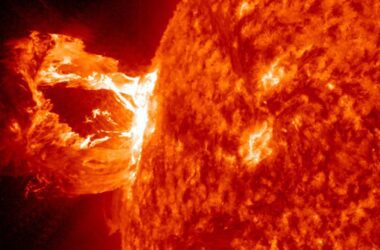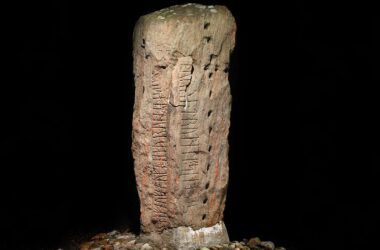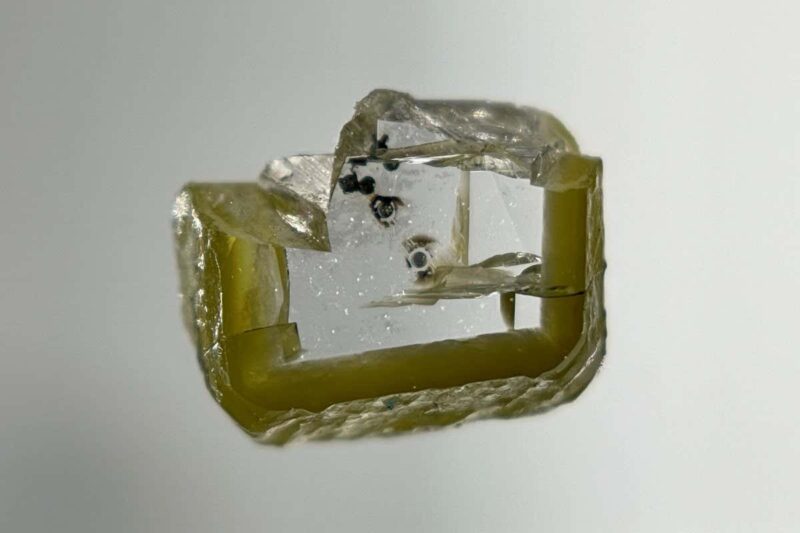A diamond that had crystals of davemaoite inside it
Aaron Celestian, Natural History Museum of Los Angeles County
A hitherto unseen material from Earth’s interior was recently discovered inside an antique diamond unearthed in Botswana. The mineral, davemaoite, is an excellent example of how the chemistry of the Earth’s interior may be studied.
The 81-milligram diamond is roughly 4 millimetres in diameter and was originally unearthed in a mine in Orapa, Botswana. In 1987, a dealer sold it to a diamond researcher at the California Institute of Technology, but neither the dealer nor the researcher realised the diamond was so rare and valuable.
Recent analysis of the diamond, which is now housed in California’s Natural History Museum of Los Angeles County, was conducted by Oliver Tschauner of the University of Nevada, Las Vegas. He is looking for “super-deep diamonds” all around the world to learn more about the planet’s core.
The lower mantle of the Earth begins 660 kilometres below the surface, and this is where the deepest diamonds are formed.
Using X-rays, Tschauner and his team were able to see within the Botswanan diamond, where they found microscopic crystals of a different material. They utilised a laser to cleave through the diamond and remove these crystals, and then they used mass spectrometry to determine their chemical composition.
The small crystals were identified as a previously undiscovered kind of calcium silicate thought to exist in the lower mantle. It has a perovskite structure, so called because of the cubic arrangement of its molecules.
This perovskite can only have developed at the high pressures of the lower mantle, which are over 200,000 times higher than the surface of the Earth. Its main atomic components are calcium, silicon, and oxygen. Instead, wollastonite, a white mineral with needle-like crystals, is the usual form of calcium silicate at the earth’s surface.
Tschauner and his coworkers at the Carnegie Institution for Science in Washington, DC, named the newly discovered calcium silicate mineral davemaoite after deep-Earth scientist Ho-Kwang “Dave” Mao.
Under normal circumstances, davemaoite’s crystal structure would collapse if it were transported to Earth’s surface. It probably took between 100 million and 1.5 billion years for it to make its way up to the Orapa mine, but because it was confined inside a hard diamond, it was preserved on the long journey there.
After the diamond was shattered, the davemaoite remained solid for a split-second before Tschauner and his team observed its expansion and bulging under a microscope, revealing that it had essentially turned into glass.
Davemaoite is important because it is hypothesised to hold radioactive elements like uranium, thorium, and potassium-40, which heat Earth as they decay, making up roughly 5% of the lower mantle. “Without these radioactive elements, the Earth would have cooled by now,” says David Phillips of the University of Melbourne in Australia.
Phillips notes that the presence of sodium and potassium in the davemaoite found in the Botswanan diamond is unexpected given that these elements are typically assumed to be more common in the Earth’s crust than in the deep mantle. This demonstrates that matter from the crust is being reincorporated into the mantle.
Researchers like Tschauner are still looking for ultra-deep diamonds in the hopes of unearthing other previously unknown minerals. This is a difficult task because there are no foolproof methods for telling which diamonds come from shallow or deep deposits, and no way to predict where the deep type will be located. We don’t know where to search,” Tschauner believes is the problem.
FAQs
- What is davemaoite, and why is its discovery significant?
- Davemaoite is a newly discovered mineral found within a diamond from Earth’s mantle. Its presence provides insights into the chemistry of Earth’s interior and the role of radioactive elements.
- How was davemaoite discovered within a diamond?
- Through X-ray analysis, microscopic crystals of davemaoite were identified within a diamond found in Botswana. The diamond was later cleaved, and mass spectrometry revealed the chemical composition of the crystals.
- Why is the location of the diamond’s origin important?
- The diamond originated from Earth’s lower mantle, starting about 660 kilometers below the surface. This region holds deep-Earth minerals and insights into Earth’s core.
- What is the unique crystal structure of davemaoite?
- Davemaoite has a perovskite structure, characterized by a cubic arrangement of its molecules. This structure forms under extreme pressures in the lower mantle.
- Why is the presence of radioactive elements significant in davemaoite?
- Davemaoite is believed to contain radioactive elements like uranium, thorium, and potassium-40. These elements contribute to Earth’s heat generation through decay.
- What does the preservation of davemaoite within a diamond suggest?
- Davemaoite likely remained preserved within the diamond due to the extreme conditions during its journey from Earth’s lower mantle to the surface. It turned into glass upon exposure.
- How does davemaoite challenge our understanding of Earth’s composition?
- The discovery of sodium and potassium in davemaoite contradicts the assumption that these elements are more common in Earth’s crust. This suggests matter from the crust is being recycled into the mantle.







